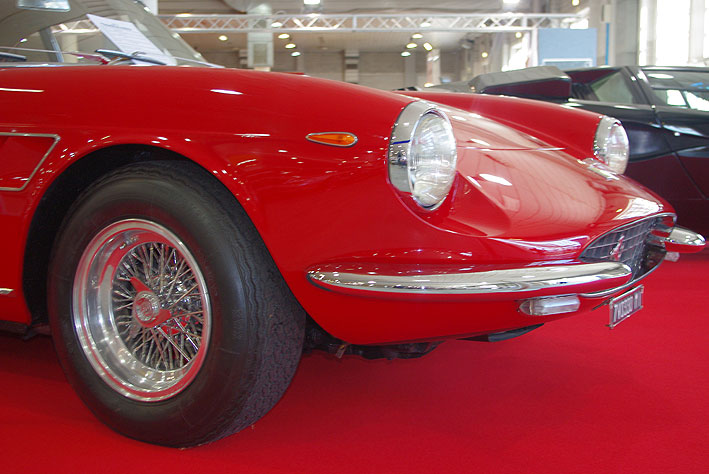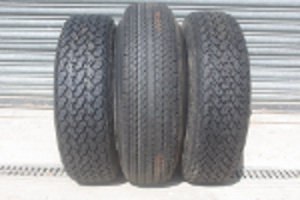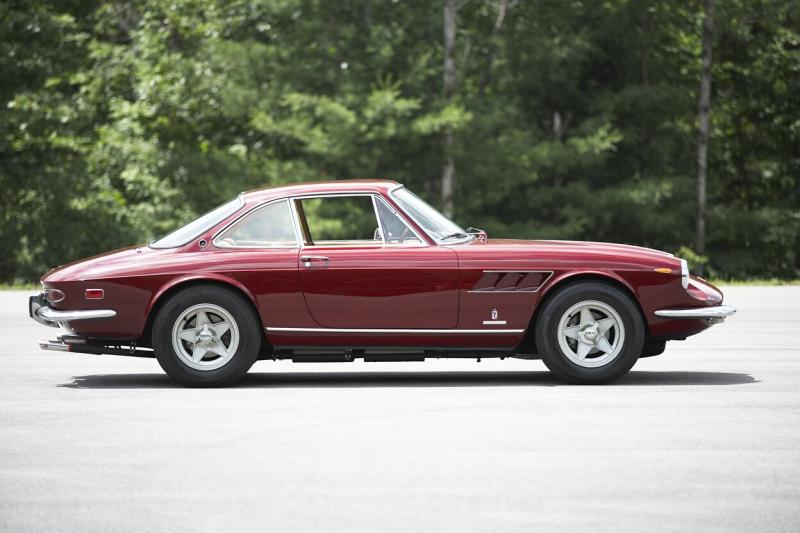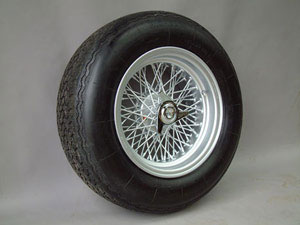Ferrari 365 Tyres

Ferrari 365 Tyres
The Ferrari 365 was Ferrari's large front-engine, rear-wheel-drive 2- and 2+2-seater grand tourer line. Introduced at the 1966 Geneva Motor Show, it replaced the 330 and 500 Superfast. The 365 Ferrari was equipped with 215/70x15 or 205VR15 tyres as standard.
Ferrari 365 California tyres
The Classic 365 California Ferrari originally fitted a 205VR15 PIRELLI CINTURATO CN72™.
In 1966 Ferrari introduced the 365 California at the Geneva Auto Show as a replacement for the Ferrari 500 Superfast. The famous coachbuilder, Pininfarina had been tasked with creating the body for the vehicle. The result was a two door, two-seat, convertible. The 365 borrowed many of the mechanics of its predecessor including the five-speed manual gearbox, chassis and suspension. The front of vehicle was similar in design to the 500 with the remaining portions all new. With a top speed of 149 mph, it was the fastest convertible in the world at the time. Disc brakes provided excellent stopping power for the 1300 kg vehicle. Production continued for only a year with a total of fourteen examples being created.
Ferrari 365 GT 2+2 tyres
The Classic Ferrari 365 GT 2+2 originally fitted a 205HR15 PIRELLI CINTURATO ™. Some cars have been fitted with the 215/70x15 Michelin XWX as an alternative. There is also: PIRELLI CINTURATO ™ 215/70VR15 CN12 which was an option offered by Ferrari in 1971.

The picture above shows the 205VR15 CN72 CINTURATO ™ HS tyre that PIRELLI put into production in 1964, which was original equipment for the Ferrari 365 GT 2+2. On either side of this tyre are more modern 70% profile tyre sizes that are often fitted by mistake. On the left is a 205/70VR15, which is far too small in diameter, and on the right is a 215/70VR15 which is closer in dimensions and would also be a good tyre for the Ferrari 365 GT 2+2. Some cars that fitted the 205VR15 CINTURATO ™ changed to the 215/70VR15 tyre when the low profile tyre was developed at the beginning of the 1970's.
If you require new Borrani wire wheels for your Ferrari then please click here for information on Borrani wire wheels.
In 1967 Ferrari introduced the 365 GT2+2, only its second production four-seater vehicle. The vehicle would stay in production until 1971 during which around 800 examples being created.
The rear passengers had limited headroom but there was sufficient legroom for most passengers. The purpose of the vehicle was to provided performance and comfort. As a result the vehicle was outfitted with electric windows, leather interior, power assisted brakes, full carpeting, and optional air conditioning.
Ferrari 365 GTC tyres
The Ferrari 365 GTC originally came with a 205VR14 Michelin XWX tyre.
Near the close of 1968, Ferrari introduced the 365 GTC which stayed in production until 1970. During the production lifespan, 168 examples were produced. The 365 GTC was basically a 330 GTC with a SOHC 4390 cc V-12 engine. Visually, the vehicle was very similar to its predecessor except for the air vents in the front wings had been removed. In their place were black vents placed in the back corners of the hood.
Ferrari 365 GTS tyres
The Ferrari 365 GTS originally came with a 215/70x15 Michelin XWX or 215/70VR15 PIRELLI CINTURATO ™ CN12 tyres. These are both excellent tyres and will flatter the performance of your 365 GTS The 365 GTS was a replacement for the 330 GTS. It featured a 4390 cc SOHC engine and had its cooling vents removed in favour of vents in the hood. Only twenty examples were created.
Ferrari 365 GTC/4 tyres

The Ferrari 365 GTC originally came with a 215/70x15 Michelin XWX or 215/70VR15 PIRELLI CINTURATO ™ CN12 tyre. Without doubt these are still the best tyres to fit to the 365GTC/4 today. In 1971 Ferrari introduced the 365 GTC/4 as a replacement for the 365 GT 2+2. It sat atop a Daytona chassis and given an independent suspension. The same Daytona ventilated disc brakes were used. The gearbox was mounted in the front and the engine was the 4390 cc V12 but with six side draught Weber carburetors and wet sump lubrication resulting in 340 horsepower. The design was once again handled by Pininfarina. The two-door, 2+2 coupe had pop-up headlights and five-spoke alloy wheels. During its production lifespan lasting until 1972, around 500 examples were produced. Strict American safety and emission regulations were partly responsible for the demise of the GTC/4.
Ferrari 365 GT4 2+2 tyres
The Ferrari 365 GTC originally came with a 215/70x15 Michelin XWX tyre. We also have an excellent 215/70VR15 PIRELLI CINTURATO ™ CN12 which this 1971 tyre is also a perfect option for the 365 GT4 2+2. The 365 GT4 2+2 was debuted to the public at the 1972 Paris Auto Show as a replacement for the 365 GT 2+2 and the 365 GTC/4. It sat atop an enlarged 365 GTC/4 chassis and given the same mechanics. The larger chassis meant more interior room for the passengers, especially the rear passengers, and their luggage. The styling was once again assigned to Pininfarina. The design was different from the prior 365 models. During its production lifespan lasting until 1976, around 470 examples were created.
Ferrari 365 GT4 BB tyres
The Ferrari 365 GTC originally came with a 215/70x15 Michelin XWX tyre at the front and a 225/70x15 Michelin XWX at the rear.
The 365 GT4 BB, meaning Berlinetta Boxer, was introduced to the public at the 1971 Turin Auto Show. Its styling was similar to the P6 show car built in 1968. The engine was a flat-12 cylinder power-plant mounted longitudinal. The gearbox was mounted under the engine. This was a great design but ultimately created an unbalanced weight distribution with most of the weight over the rear axle. The weight distribution problem and the fact that the engine was mounted high in the vehicle resulted in a car that had poor handling and never achieved successful racing status.
The 365 GT4 BB was replaced by the 512 BB in 1976. The 512 BB was similar in design but featured a five-liter engine.
Please visit www.365gtc4.com, a website dedicated strictly to the Ferrari 365 GTC/4 model. Here you will find a wealth of historic and technical information about this elegant Ferrari model, as well as many vintage and contemporary photos of fine 365 GTC/4's. In addition, there is a discussion board where owners discuss everything 365 GTC/4-related.
The first of the 365 Ferraris were introduced in the late 1960's and stayed in production until the early 1970's. The 365's were often powered by a Columbo SOHC 4390 cc V-12 engine with three Weber carburetors capable of producing around 300 horsepower. The front and rear suspension for most of the series was independent with double wishbones and coil springs. The 365 GT4 2+2 had an independent with transverse parallelograms and coil springs suspension. The 365 California had a live axle with coil springs rear suspension. The chassis was an oval tube ladder type frame layout.
Disc brakes were standard on all the vehicles, as was the five-speed manual gearbox. Many of the series received standard options such as power steering and air conditioning, uncommon at the time. When most manufacturers such as Lamborghini and DeTomaso were creating vehicles with mid-engined design, Ferrari continued to use their tried-and-true front-engined, rear wheel design.
In 1967 Ferrari dominated the Daytona 24 Hours race with a first, second and third place finish. At the 1968 Paris Auto Show the public and press were expecting Ferrari's new berlinetta to be dubbed 'Daytona'. They were proven wrong when Ferrari dubbed the vehicle the 365 GTB/4, however, the name Daytona is a common reference to the vehicle even to this day. Ferrari had intended on using 'Daytona' but it was revealed prematurely so the traditional Ferrari naming sequence was used.
During its production lifespan lasting from 1968 through 1974, 1383 examples of the Pinifarina designed 365 GTB/4 Daytona vehicles were created.
The famous coachbuilder Pininfarina was tasked with creating many of the designs for the 365 Series. The designs were not new, rather they borrowed many of the styling cues of the prior 330 GTC and 275 GTS models. The headlights were courtesy of the 500 Superfast. The result was a visually stunning automobile with proven Ferrari mechanics and performance.
GT represented Gran Turismo. GTB represented Berlinetta or coupe. GTS stood for open models which were either a targa roof or a full convertible. '4' represented four-cam engines. 'C' represented 'Competizione' or 'Corsa' meaning 'to race'.

